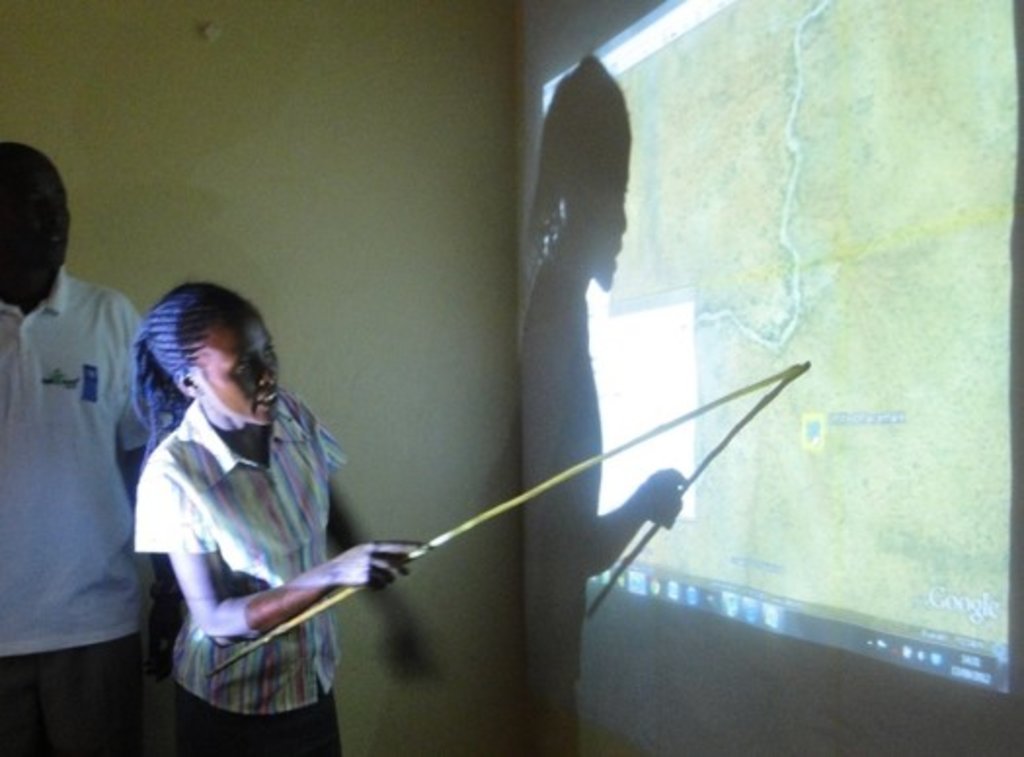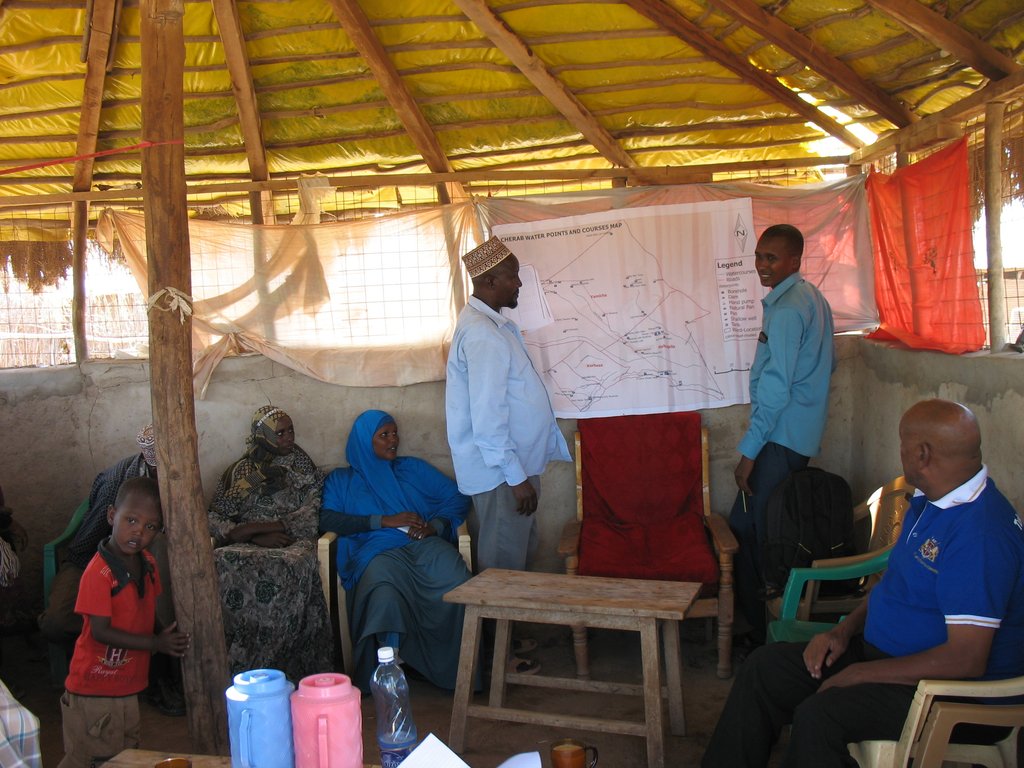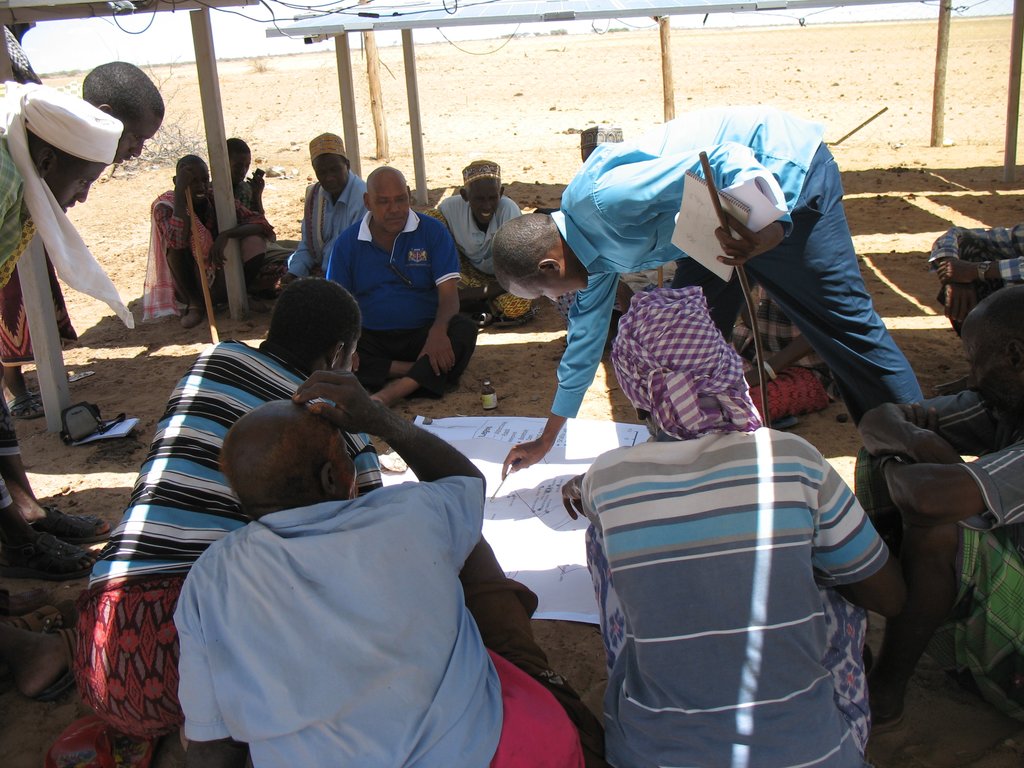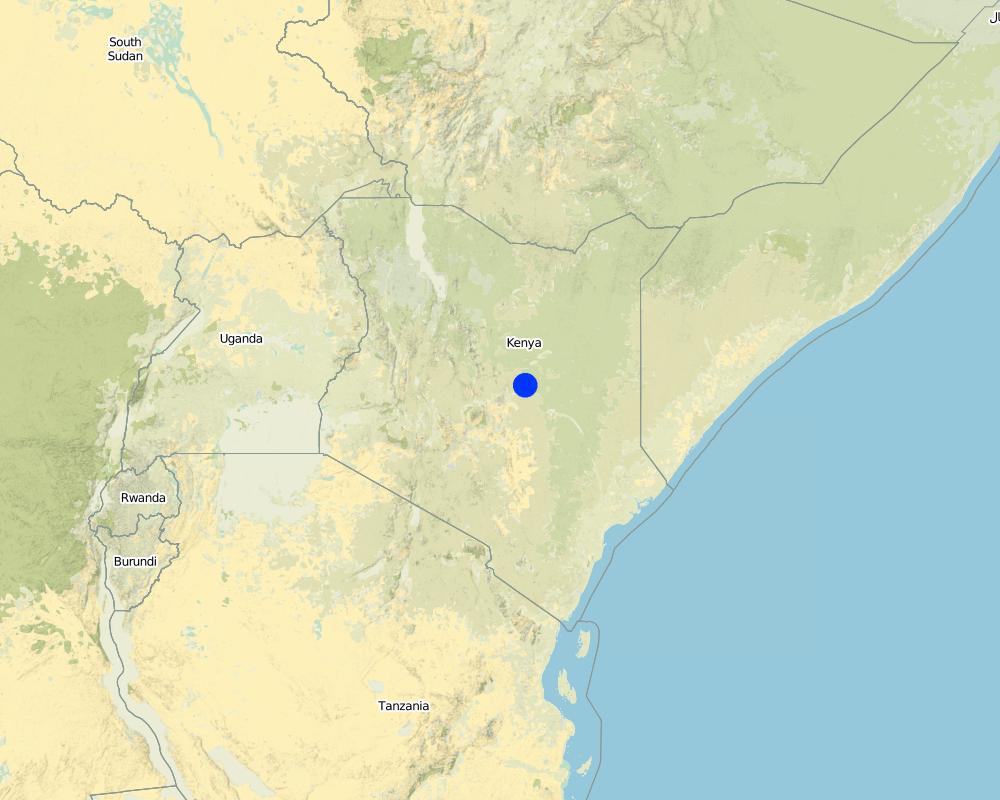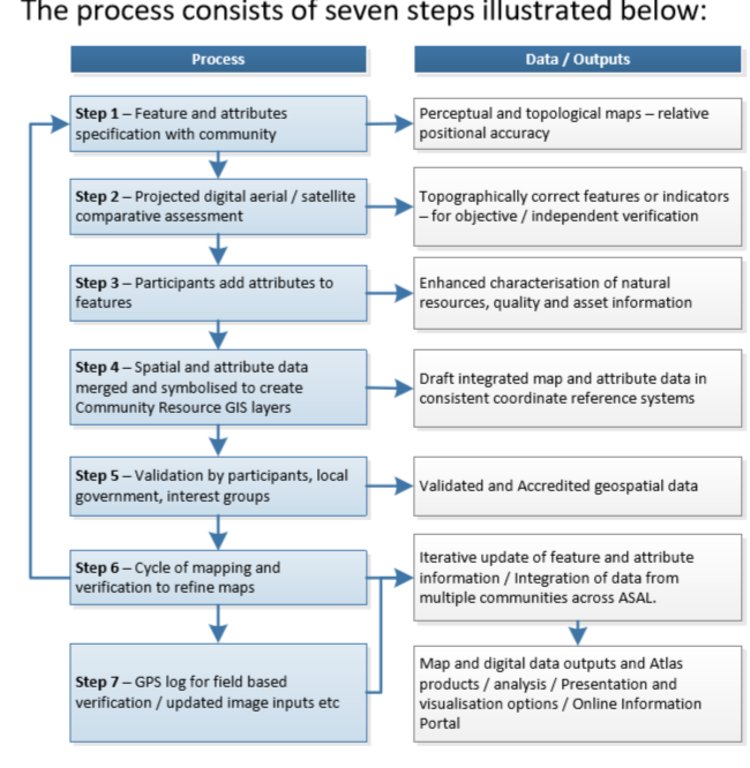Participatory mapping, database building, and monitoring of rangeland resources [كينيا]
- تاريخ الإنشاء:
- تحديث:
- جامع المعلومات: IBRAHIM JARSO
- المحرر: Caroline King-Okumu
- المراجعون: Rima Mekdaschi Studer, Donia Mühlematter
Resource Mapping
approaches_3439 - كينيا
- Participatory mapping, database building, and monitoring of rangeland resources: 5 يوليو، 2018 (inactive)
- Participatory mapping, database building, and monitoring of rangeland resources: 31 يوليو، 2018 (inactive)
- Participatory mapping, database building, and monitoring of rangeland resources: 5 يوليو، 2018 (inactive)
- Participatory mapping, database building, and monitoring of rangeland resources: 3 سبتمبر، 2018 (inactive)
- Participatory mapping, database building, and monitoring of rangeland resources: 22 مايو، 2018 (inactive)
- Participatory mapping, database building, and monitoring of rangeland resources: 13 مايو، 2018 (inactive)
- Participatory mapping, database building, and monitoring of rangeland resources: 2 نوفمبر، 2021 (public)
- Participatory mapping, database building, and monitoring of rangeland resources: 19 مايو، 2018 (inactive)
عرض الأقسام
توسيع الكل طي الكل1. معلومات عامة
1.2 تفاصيل الاتصال بالأشخاص الرئيسيين لمصدر المعلومات والمؤسسات المعنية بتقييم وتوثيق النهج
مستخدم الأرض:
Konsole Hussein
+254 728 064578
saritehussein@yahoo.com
Garbatulla Ward Adaptation Planning Committee
P.O. BOX 1 Garbatulla
كينيا
Non-State Actor:
Abdullahi Shandey
+254 721109171
midp2003@gmail.com
Merti Integrated Development Program (MID-P)
Merti Village Isiolo Kenya
كينيا
متخصص في الإدارة المستدامة للأراضي:
اسم المشروع الذي سهّل توثيق/تقييم النهج (إذا كان ذلك على صلة)
Strengthening Adaptation and Resilience to Climate Change in Kenya Plus (StARCK+)اسم المؤسسة (المؤسسات) التي سهلت توثيق/تقييم النهج (إذا كان ذلك على صلة)
Resource Advocacy Programme (RAP) - كينيا1.3 الشروط المتعلقة باستخدام البيانات الموثقة من خلال WOCAT
متى تم تجميع البيانات (ميدانيا)؟:
16/01/2018
يوافق جامع المعلومات والشخص (لاشخاص) الرئيسي لمصدر المعلومات على الشروط المتعلقة باستخدام البيانات الموثقة من خلال WOCAT:
نعم
1.4 المراجع الخاصة باستبيان(استبيانات) تقنيات الإدارة المستدامة للأراضي
2. وصف نهج الإدارة المستدامة للأراضي
2.1 وصف موجز للنهج
Participatory mapping and monitoring of vegetation types and other natural resources in the rangelands. This involves convening stakeholder groups, reviewing conditions of rangeland, water and other resources under changing climatic conditions.
2.2 وصف تفصيلي للنهج
وصف تفصيلي للنهج:
Participatory digital mapping using satellite imagery and digital earth and other open source Geographic Information Systems (GIS) is a practical tool that can bridge knowledge and communication gaps between pastoral communities and county government planners. It offers an effective ‘tool’ for participatory planning and decision-making in support of climate change adaptation efforts in the drylands of Kenya.
The use of participatory mapping is not new in seeking to capture communities’ understanding and use of natural resources. These maps are typically drawn on the ground using stones, sticks and other locally available materials to depict key features such as schools, water points, and forest areas, etc. However the process used in Isiolo County combines digital mapping with community-drawn perception maps. This offers a number of extra benefits. While fully capturing the wealth of local knowledge, they contain an in-built coordinate system which corresponds to a global reference grid, enabling their linkage to maps used in formal systems. Furthermore, the coordinate system provides a geographically precise basis from which to discuss natural resource management, making outputs of participatory mapping more universally useable. These benefits, however, need to be carefully balanced to avoid the risk that through this process, pastoral resources – which are highly dynamic - are ‘frozen’ in time and space.
Mapping process
The participatory mapping process has adopted GIS workflows within community workshops, enabling the creation of integrated, consistent and standardized geospatial information. The process follows seven steps:
Step 1: Community level meetings to develop perception maps drawn on the ground and/or on paper. The product is a community perception map of those resources that are important for their livelihood systems. This map should be created in a community setting to enable the participation of a large group. Several maps may be produced by smaller sub-groups (women, the youth, elders etc) and then amalgamated. The final map is then copied onto paper.
Step 2. Digital mapping is introduced. This step takes place in a workshop setting with a smaller group of key informants chosen by the community - as well as county government planners and technical staff. The presence of the latter is critical to the process of ‘legitimizing’ community knowledge. Following a quick explanation of satellite imagery, Google Earth is projected onto a wall alongside the perception maps developed under step 1. The use of Google Earth is only for orientation, and to enable participants to navigate the imagery and to cross-reference their paper-mapped key resources against the satellite imagery. Features that participants feel are important (e.g. water points, wet and dry season grazing areas, drought reserves, wildlife routes) are then captured digitally using open source applications: Quantum GIS (QGIS) and JOSM, the Open Street Map editing platform.
This produces the coordinates that pinpoint the locations of natural resources in a manner that can be independently and objectively verified. The highly interactive process of geo-referencing local knowledge to a coordinate reference system allows resource maps to be produced to any scale, and in real-time, with the community.
Step 3. Qualitative and quantitative attributes describing the key resources are collected. As participants add features to the map, they also describe their specified characteristics or attributes. Attribution data includes a fuller description of the physical characteristics of the resource (e.g. soil type, water
quantity and quality, pasture species) as well as issues concerning their management (e.g. under customary or modern management, land tenure status, negotiated or paid access, area of conflict). Updating this data on a regular basis adds temporal and trend data to the spatial database. This underlines the need to structure data systems well to manage time-based data and to record updates.
Steps 4-6: Data verification cycles are integrated into the mapping process in order to capture community feedback and verify the records in the geospatial data and their attribute values against the specification. The mapping includes a series of validation, cross-checking and verification cycles, run with the community - and in a few instances on-the-ground verification termed ‘groundtruthing’.
Step 7: Field validation. Field validation is carried out where the verification stages highlight gaps in information. Verification consists of targeted field visits to take GPS markers, or holding meetings with the local community to clarify particular issues.
2.3 صور عن النهج
2.5 البلد/المنطقة/المواقع التي تم تطبيق النهج فيها
البلد:
كينيا
المنطقة/الولاية/المحافظة:
Isiolo
مزيد من التفاصيل حول الموقع:
Pasturalist areas
Map
×2.6 تواريخ بدء وإنهاء تنفيذ النهج
أشر إلى سنة البدء:
2012
سنة الإنهاء (إذا لم يعد النهج مطبقًا):
2015
التعليقات:
The mapping process needs to be continuous as new community resources are identified and added
2.7 نوع النهج
- قائم على مشروع/برنامج
2.8 الغايات/الأهداف الرئيسية للنهج
- To allow participation for community groups to inform planners.
- To provide the necessary precision for planners to use local knowledge effectively.
- To make a ‘bridge’ for information to flow between customary and formal institutions.
- To better share ideas through communication tools using powerful visual language.
- To demonstrate the depth of local knowledge about natural resources and with that, demonstrate the importance of these resources.
- To identify gaps and risks in the system being mapped.
- To compare one plan with another to see how complimentary/contradictory they are.
2.9 الظروف التي تمكن أو تعيق تنفيذ التقنية/التقنيات المطبقة بموجب النهج
المعايير والقيم الاجتماعية /الثقافية/ الدينية
- تمكين/تمكيني
Communities are awed by the technology that allows them to see their resources while seated in a single specific location. The approach doesn't conflict with any community social, cultural, religious norms and values.
- معيق
Minimal local capacity is required to use the technology.
توفر/الوصول إلى الموارد والخدمات المالية
- تمكين/تمكيني
A brief GIS training of four weeks can allow county government staff to develop, add and update the database.
- معيق
Short GIS training courses costs around $850 and facilitation of community engagement meetings may be costly to undertake.
الإطار المؤسساتي
- تمكين/تمكيني
The approach helps in improving planning at community and government levels, and is accepted by all stakeholders.
- معيق
Poor capacity and financial resources can be a challenge.
التعاون/التنسيق بين الجهات الفاعلة
- تمكين/تمكيني
The product of the participatory mapping process is beneficial to all actors and many are willing to engage in implementation of the approach.
- معيق
Different mapping initiatives are undertaken by actors with various objectives.
الإطار القانوني (حيازة الأراضي، وحقوق استخدام الأراضي والمياه)
- تمكين/تمكيني
The approach helps in land use planning and supports regulations meant to improve land governance such as a customary natural resource management bill.
- معيق
County governments can develop their own spatial plans, but there are only few initiatives underway to map county resources
السياسات
- تمكين/تمكيني
Many policies and laws (including the national constitution) support the mapping of resources to improve land use planning.
- معيق
Conflicts over land undermines political will.
حوكمة الأراضي (صنع القرار والتنفيذ والإنفاذ)
- تمكين/تمكيني
The approach allows communities to develop their land use plans for resource utilisation, and digitize them - making the work of land governance easier.
- معيق
Competing claims over land and land-based resources in community lands means enforcement of the approach is often challenged. Resources along administrative boundaries are claimed by different communities.
المعرفة حول الإدارة المستدامة للأراضي، والوصول إلى الدعم الفني
- تمكين/تمكيني
New graduates in dryland resource management, and communities' reception of the new technologies, help in acceptance and implementation of the technology.
- معيق
58% of the residents of the county (according to the Kenya National Bureau of Statistics socio-economic survey report of 2016) are illiterate and may have difficulties engaging properly with the technology.
الأسواق (لشراء المدخلات وبيع المنتجات) والأسعار
- تمكين/تمكيني
Free open source programmes are available to digitize local knowledge to geo-referenced products.
- معيق
Good programmes for mapping are expensive.
عبء العمل، توفر القوى العاملة
- تمكين/تمكيني
The technology makes the process simpler and reduces the workload.
- معيق
The processes can be tedious because of the paper maps involved, series of validation and verification of features.
3. المشاركة وأدوار الأطراف المعنية
3.1 أصحاب المصلحة المعنيون بالنهج وأدوارهم
- مستخدمو الأراضي المحليون/المجتمعات المحلية
Jarsa Dedha (customary natural resource management institutions) Community Members (i.e. pastoralists).
Jarsa Dedha identify the most knowledgeable elders from different grazing areas to help in identifying features and providing grazing land management plans that are in place. Community members identify features and contribute to the attributes of the features.
- المنظمات المجتمعية
Kinna Integrated community based initiative (KICBI)
Ward Adaptation Planning Committees
They identify features and also contribute to attributes of the features
- متخصصون في الإدارة المستدامة للأراضي / مستشارون زراعيون
Ibrahim Jarso
Support mapping process and also add new features supporting updates to the products.
- منظمة غير حكومية
Resource Advocacy Program (RAP)
Merti Integrated Development Program (MID-P)
Adaptation Consortium
Support the mapping process and mobilize communities and stakeholders for the approach to be implemented properly.
- الحكومة المحلية
Isiolo County Government
Support the mapping process with intention to use product for planning purpose and own the product
- الحكومة الوطنية (المخططون، صانعو القرار)
Kenya's National Government
Support the planning process - also with the intention of using the product for planning.
- منظمة دولية
International Institute for Environment and Development (IIED) and the
University of Southampton (Geodata Institute)
Support with funding to implement the approach and also provide technical expertise to undertake GIS processing of data.
إذا كان هناك العديد من الأطراف المعنية، قم بالإشارة إلى الوكالة الرائدة:
WAPC , ADA and IIED
3.2 انخراط مستخدمي الأراضي المحليين/المجتمعات المحلية في المراحل المختلفة للنهج
| انخراط مستخدمي الأراضي المحليين/المجتمعات المحلية | حدد من شارك وصف الأنشطة | |
|---|---|---|
| المبادرة/التحفيز | سلبي | Resource Advocacy Programme (RAP) undertook discussions with the local community and also with the county and national government in shaping the idea for the approach. |
| التخطيط | تفاعلي | All stakeholders (community, RAP, ADA, IIED, Geodata and Governments) were engaged in the planning for the implementation of the Approach. |
| التنفيذ | تفاعلي | Community members and all stakeholders were involved in the implementation of the participatory mapping. |
| الرصد/التقييم | سلبي | The county government and the actors (RAP, ADA and IIED) monitor the participatory mapping database and improves it. |
3.3 مخطط التدفق (إذا كان متاحًا)
الوصف:
Participatory mapping of community resources has seven steps, which can be summarised under the main groupings of: consultations with the community where key features are identified and mapped on paper; digitization of community identified points by GIS specialists; processing of the data where community identified attributes are incorporated into the data; and feedback sessions for community validation and verification.
المؤلف:
Ibrahim Jarso
3.4 اتخاذ القرار بشأن اختيار تقنية/تقنيات الإدارة المستدامة للأراضي
حدد من الذي قرر اختيار التقنية/التقنيات التي سيتم تنفيذها:
- جميع الجهات الفاعلة ذات الصلة، كجزء من نهج تشاركي
اشرح:
The process requires inputs from all the relevant stakeholders. The community provide local knowledge of the features, GIS specialists provide technical expertise and the other local stakeholders provide their knowledge and experience of working in the communities for many years.
حدد على أي أساس تم اتخاذ القرارات:
- خبرة وآراء شخصية(غير موثقة)
4. الدعم الفني وبناء القدرات وإدارة المعرفة
4.1 بناء القدرات/التدريب
هل تم تقديم التدريب لمستخدمي الأراضي / الأطراف المعنيين الآخرين؟:
نعم
حدد من تم تدريبه:
- مستخدمو الأراضي
- موظفون ميدانيون/ مستشارون
إذا كان ذلك على صلة، حدد الجنس والعمر والوضع والعرق وما إلى ذلك.
5 persons trained- One from County Government (Planning Unit), Two from National government (National Drought Management Authority and Kenya Meteorological Department (KMD)) and Two representative of Local NGOs (RAP and MID-P)
شكل التدريب:
- في العمل
- دورات
المواضيع المغطاة:
Participatory GIS mapping techniques
Input of data using different platforms
Use of GPS devices
Validation of data
Data management
التعليقات:
The training was well done with seminars and practical sessions
4.2 خدمة استشارية
هل يملك مستخدمو الأراضي وصولا إلى خدمة استشارية؟:
نعم
حدد ما إذا كانت الخدمة الاستشارية متوفرة:
- في حقول مستخدمي الأراضي
وصف/تعليقات:
practical sessions were provided in the field and with communities
4.3 تعزيز المؤسسات (التطوير التنظيمي)
هل تم إنشاء أو تعزيز مؤسسات من خلال هذا النهج؟:
- نعم، باعتدال
حدد المستوى (المستويات) التي تم فيها تعزيز أو إنشاء المؤسسات:
- محلي
صف المؤسسة والأدوار والمسؤوليات والأعضاء وما إلى ذلك.
Local institutions were able to use the maps to advocate for improved planning.
حدد نوع الدعم:
- بناء القدرات/التدريب
اعط مزيدا من التفاصيل:
Courses/trainings were provided
4.4 الرصد والتقييم
هل يشكل الرصد والتقييم جزءا من النهج؟:
نعم
التعليقات:
inputs were monitored
إذا كانت الإجابة بنعم، فهل من المقصود استخدام هذه الوثائق للمراقبة والتقييم؟:
نعم
التعليقات:
It was also used to mapped investments that were done to improve community livelihoods
4.5 البحوث
هل كانت البحوث جزءًا من النهج؟:
نعم
حدد المواضيع:
- علم الايكولوجيا
أعط تفاصيل إضافية وأشر إلى من قام بالبحوث:
Research on vegetation patterns in Isiolo’s rangelands were conducted by the University of Nairobi's Department of Land and Resource Management.
5. التمويل والدعم المادي الخارجي
5.1 الميزانية السنوية لمكون الإدارة المستدامة للأراضي في النهج المذكور
إذا لم تكن الميزانية السنوية الدقيقة معروفة، قم بالإشارة إلى نطاقها:
- 100,000-10,000
التعليقات (على سبيل المثال المصادر الرئيسية للتمويل/الجهات المانحة الرئيسية):
The approach was supported by RAP and IIED under the Adaptation Consortium with funding from UK's Department for International Development (DfID). The budget is used to convene sub-county level meetings and trainings sessions. Many of the participants costs and preparation costs are not covered.
5.2 الدعم المالي/المادي المقدم لمستخدمي الأراضي
هل حصل مستخدمو الأراضي على دعم مالي/ مادي لتنفيذ التقنية/ التقنيات؟:
كلا
5.3 إعانات لمدخلات محددة (بما في ذلك العمالة)
- عمالة
| إلى أي مدى | حدد الإعانات |
|---|---|
| ممول بالكامل | Community meetings were supported by the actors in the project (RAP, IIED and Adaptation Consortium). |
- معدات
| حدد المدخلات التي تم دعمها | إلى أي مدى | حدد الإعانات |
|---|---|---|
| الآلات | ممول بالكامل | Machinery used in the approach was purchased by the actors involved. |
| أدوات | Tools used in the approach were purchased by the actors involved. | |
إذا كان العمل من قبل مستخدمي الأراضي مدخلاً جوهريًا، فهل كان:
- تطوعي
التعليقات:
Communities provided the local knowledge to support the approach.
5.4 الائتمان
هل تم توفير ائتمان في إطار نهج أنشطة الإدارة المستدامة للأراضي؟:
كلا
6. تحليل الأثر والتصريحات الختامية
6.1 آثار النهج
هل ساهم النهج في تمكين مستخدمي الأراضي المحليين وتحسين مشاركة الأطراف المعنية؟:
- لا
- نعم، قليلا
- نعم، باعتدال
- نعم، إلى حد كبير
Yes, the approach strengthens community rights and management of resources.
هل مكّن النهج من اتخاذ القرارات المبنية على الأدلة؟:
- لا
- نعم، قليلا
- نعم، باعتدال
- نعم، إلى حد كبير
Yes greatly – provided databases that did not previously exist.
هل ساعد النهج مستخدمي الأراضي على تنفيذ وصيانة تقنيات الإدارة المستدامة للأراضي؟:
- لا
- نعم، قليلا
- نعم، باعتدال
- نعم، إلى حد كبير
Strengthened the traditional system of management of land.
هل نجح النهج في تحسين التنسيق والتنفيذ الفعال من حيث التكلفة لأنشطة الإدارة المستدامة للأراضي؟:
- لا
- نعم، قليلا
- نعم، باعتدال
- نعم، إلى حد كبير
Improved coordination among the partners and enabled monitoring of resource conditions.
هل أدى النهج إلى تحسين معرفة وقدرات مستخدمي الأراضي على تنفيذ الإدارة المستدامة للأراضي؟:
- لا
- نعم، قليلا
- نعم، باعتدال
- نعم، إلى حد كبير
The technology provided digitized observation of resources, and communities realised their wealth of their resources.
هل أدى النهج إلى تحسين معرفة وقدرات الأطراف المعنية الأخرى؟:
- لا
- نعم، قليلا
- نعم، باعتدال
- نعم، إلى حد كبير
The Community resource atlas of Isiolo County has been online since July 2015.
Yes greatly, the Approach made local institutions stronger and enhanced their collaboration and data sharing.
هل ساهم النهج في التخفيف من حدة الصراعات؟:
- لا
- نعم، قليلا
- نعم، باعتدال
- نعم، إلى حد كبير
The Approach mapped conflict hotspots and improved the process of conflict resolution and analysis.
هل أدى النهج إلى تحسين المساواة بين الجنسين وتمكين النساء والفتيات؟:
- لا
- نعم، قليلا
- نعم، باعتدال
- نعم، إلى حد كبير
The process also engaged women in gathering local knowledge of resources and they made a very considerable contribution to the work.
هل شجع النهج الشباب/الجيل القادم من مستخدمي الأراضي على الانخراط في الإدارة المستدامة للأراضي؟:
- لا
- نعم، قليلا
- نعم، باعتدال
- نعم، إلى حد كبير
The use of GIS fascinated young people and they felt attracted to the process.
هل أدى النهج إلى تحسن في مسائل حيازة الأراضي / حقوق المستخدمين التي أعاقت تنفيذ تقنيات الإدارة المستدامة للأراضي؟:
- لا
- نعم، قليلا
- نعم، باعتدال
- نعم، إلى حد كبير
The approach guided use of land and also strengthened communities ownership and rights over their land and their available resources.
هل أدى النهج إلى تحسين الوصول إلى المياه والصرف الصحي؟:
- لا
- نعم، قليلا
- نعم، باعتدال
- نعم، إلى حد كبير
The approach guided water investments in the community lands and improved placement of water infrastructure.
هل أدى النهج إلى استخدام طاقة/ مصادر طاقة أكثر استدامة؟:
- لا
- نعم، قليلا
- نعم، باعتدال
- نعم، إلى حد كبير
The approach mapped boreholes, and the energy used to extract water from them, as well as encouraging use of clean and green energy.
هل أدى النهج إلى تحسين قدرة مستخدمي الأراضي على التكيف مع التغيرات المناخية/الظواهر المناخية المتطرفة والتخفيف من الكوارث المرتبطة بالمناخ؟:
- لا
- نعم، قليلا
- نعم، باعتدال
- نعم، إلى حد كبير
The approach concretized the community land use plans and guided proper use of their pasture and water - enhancing the community's capacity to adapt to climate related disasters of drought and floods.
6.2 المحفز الرئيسي لقيام مستخدمي الأراضي بتنفيذ الإدارة المستدامة للأراضي
- زيادة الإنتاج
The Approach improved planning and management of resources leading to increased productivity
- الحد من تدهور الأراضي
Mapping of Land use plans helped in reducing land degradation.
Participatory Mapping Approach was used by International Union for Conservation of Nature (IUCN) to map out degaraded lands in the County and targetted interventions were undertaken with Dedha elders.
- الحد من مخاطر الكوارث
The approach allowed the communities to plan and prepare before disasters happen by identifying fall back areas and mapping them.
Flood prone areas, Drought reserves and Conflict hotspots were mapped and deliberate interventions undertaken on addressing this.
- القواعد واللوائح (الغرامات) / الإنفاذ
The Approach developed Maps which guided the enforcement of the traditional rules and regulations of accessing pasture and water during specific seasons.
- الوعي البيئي
The approach mapped key environmental resources like non-gazette forests with opportunity to enhance protection and conservation
- تعزيز المعرفة والمهارات في مجال الإدارة المستدامة للأراضي
Supported the traditional systems of management of natural resources
- التخفيف من حدة الصراع
The approach mapped the conflict hotspots in the county with intention to resolve or mitigate conflicts
6.3 استدامة أنشطة النهج
هل يمكن لمستخدمي الأراضي المحافظة على استدامة ما تم تنفيذه من خلال النهج (بدون دعم خارجي)؟:
- غير مؤكد
إذا كان الجواب لا أو غير متأكد، حدد ذلك وعلق عليه:
The approach was implemented with support from donors and county government. Although in theory, it could be possible for resource users to auto-finance the Approach, this has not ever happened previously, and many of the resource users are not wealthy. Support is available for devolved development planning and mapping, but as yet this has not been assigned to participatory resource mapping.
6.4 نقاط قوة/مزايا النهج
| نقاط القوة/ المزايا/ الفرص من وجهة نظر مستخدمي الأراضي |
|---|
| It is a promising new approach that builds on the legitimacy of local/indigenous knowledge, and enables the county government to fulfil its mandate of undertaking participatory planning with communities. |
| GIS technology helps in the acceptance of the approach by many land users. |
| The mobililty of the technology can provide an opportunity for all community members to add features as they come up |
| نقاط القوة/ المزايا/ الفرص من وجهة نظر جامع المعلومات أو غيره من الاشخاص الرئيسيين لمصدر المعلومات |
|---|
| It is a user friendly approach accepted and recognized by Isiolo pastoralists for mapping their rangeland resources. |
| It provides an opportunity to map all investments of development partners in the county and avoid duplication of projects. |
| It is a powerful tool for communication and advocacy for community land rights. |
6.5 نقاط الضعف/ العيوب في المنهج وطرق التغلب عليها
| نقاط الضعف/ المساوىء/ المخاطر من وجهة نظر مستخدم الأراضي | كيف يمكن التغلب عليها؟ |
|---|---|
| It requires time and commitment from community members and county officers. | Systematic use of media (e.g. radio, websites, etc) to publicize the approach and its importance to the community. |
| It is difficult for illiterate community members to fully engage with the approach and make meaningful contributions. | Provide local translations and interpretation as well as producing good visual maps. |
| نقاط الضعف/ المساوىء/ المخاطر من وجهة نظر جامع المعلومات أو غيره من الاشخاص الرئيسيين لمصدر المعلومات | كيف يمكن التغلب عليها؟ |
|---|---|
| There is a need for continuous updating | Engage local universities and students. |
| Observation of key features and resources are sometimes obscured by clouds and thus mapping precision is affected. | Ground truthing visits and observations need to be undertaken to improve precision. |
| Lack of legislation to support and enforce the use of the approach. | Formulate legislation to support enforcement. |
7. المراجع والروابط
7.1 طرق جمع/مصادر المعلومات
- زيارات ميدانية، مسوحات ميدانية
Made 2 field visits in Kinna and Garbatulla Wards, engaged 20 community members
- مقابلات مع مستخدمي الأراضي
20 community members and 3 community based organization representatives
- مقابلات مع المتخصصين/الخبراء في الإدارة المستدامة للأراضي
Engaged 2 staff of MID-P and 2 staff of RAP
- التجميع من التقارير والوثائق الأخرى الموجودة
used Community Resource Mapping and Validation reports and Isiolo Community Resource Atlas 2015
7.2 المراجع للمنشورات المتاحة
العنوان، المؤلف، السنة، النظام القياسي الدولي لترقيم الكتب ISBN:
Participatory Mapping using Digital Earth Tools, Imagery and Open Source GIS in the drylands of Kenya and Tanzania by Chris Hill, Tom Rowley, Homme Zwaagstra, Andrew Harfoot and Mike Clark
متاح من أين؟كم التكلفة؟:
Ada Consortium Website
7.3 روابط للمعلومات ذات الصلة المتوفرة على الإنترنت
العنوان/الوصف:
Resource Atlas of Isiolo County, Kenya
عنوان الرابط URL:
pubs.iied.org/pdfs/G03984.pdf
الروابط والوحدات المواضيعية
توسيع الكل طي الكلالروابط
لا يوجد روابط
الوحدات المواضيعية
لا يوجد وحدات مواضيعية



